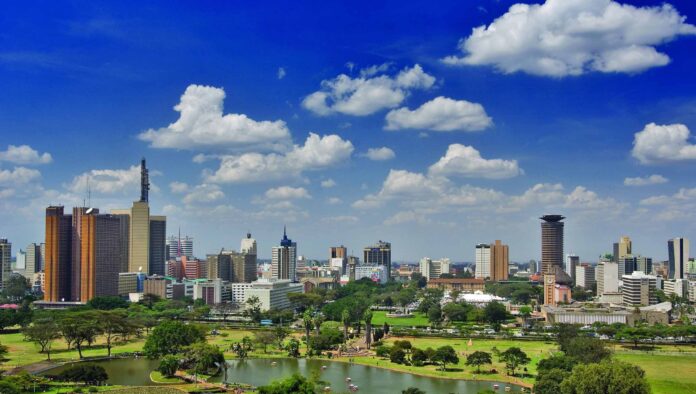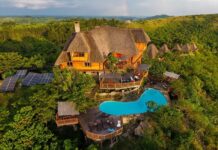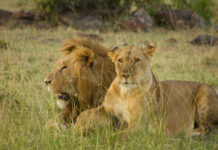You are planning to have a city tour but you are not sure of which city to visit? Kampala City, Uganda’s Capital City is such a fascinating place to see. It is endowed with a lot of tourist attractions. Teeming with rich culture and friendly people, this city offers a wide range of experiences to tourists who take the time to explore it. Here are the best tourism places to enjoy on a Kampala City Tour before you continue further for your tour in Uganda.
Uganda National Museum. Uganda Museum is the oldest museum in East Africa which was started in 1908. It was first located in Lugard’s fort on old Kampala Hill then transferred to Makerere University at the school of industrial and fine arts and lastly to Kitante Hill where it stands today. It is a collection of traditional culture and Ugandan Music with all kinds of musical instruments, archaeology, history, science, and natural history. The Museum is one of the top and best places today you can visit in your Kampala city tour because it gives you the real picture of Uganda and its people.
Kasubi Tombs. These are the burial grounds where the kings of Buganda are buried. This is because it was built purely by plant materials and so far four kings of Buganda have been buried at this site on the house called Muzibu Azaala Mpanga and it was constructed in a circular shape. Kasubi tombs as the world heritage site comprise of 26 hectares of land and it is used for agricultural purpose by using traditional techniques by the royal family members. Kasubi tombs being the burial grounds for the Kings of Buganda, it remains as a vital traditional architectural, spiritual, cultural and political site for both local and international visitors.
Independence Monument. The independence monument was constructed during the days when Uganda was celebrating its first independence on 9th October 1962 and it was funded by the British Colonial government. The monument is located on Speke Road and Nile Avenue in Kampala city bordering the fences of Sheraton Hotel gardens, overlooking Grand Imperial Hotel in the right and opposite Standard Chartered bank. The monument shows a man unwrapping a child and raising it to the sky which narrates that Uganda as a country is now free from the oppression of colonialism.
With the beauty of this monument and around this place, you will require a camera to take memorable pictures. Always remember to tell your driver guide to take you on this top and most accessible attraction within Kampala city.
Kabaka’s Lake. This is the largest manmade lake in Uganda and probably in East Africa located between Ring Road and Nabunya Road in Ndeeba Rubaga Division. It is 5 km away from the Kampala City center. It was constructed between 1885 and 1888 by 52 clans of Buganda Kingdom during the regime of Ssekabaka Mwanga 11. The lake was dug to serve as a water source and a defensive barrier for the king’s palace. Kabaka’s Lake covers an area of approximately 200 acres (0.8 square kilometers) and has an average depth of 4.5 meters. It is primarily fed by natural springs and rainwater runoff.
Kabaka’s Lake holds significant cultural and historical value in Ugandan society, particularly within the Buganda kingdom. It is considered a symbol of the kingdom’s heritage and is often used for ceremonial purposes during important cultural events. The lake’s association with the Buganda kingdom and its traditional rulers further enhances its cultural significance.
Whether in the dry o rainy season, the water Levels have always been consistent. The lake is under renovation and improvement for tourism and one of the future plans is construct a five-star hotel accommodation close to it so as to encourage a lot of tourists to visit the lake.
In the annual Buganda tourism Expo which takes place around August, the king of Buganda takes courtesy with his subjects to be of the officiate watersports on the lake. The Kabaka is accompanied by his soldiers known as Abimbola dressed smartly in their traditional attires well-armed with shields and the spears together with the ministers as well as dignitaries and a security convey.
Kabaka’s Palace. It is also known as lubiri. It is a royal compound of the Kabaka “king” of Buganda, located in Mengo, a suburb of Kampala. The 260 acres compound has a 9 ft. fence wall constructed using earthen bricks and encloses the Kabaka’s Main official residence, known as Twekobe. It also encloses a school, other building for supporting the King’s home and few matoke plantations. The kabaka palace is where most the Buganda cultural practices are carried out from. For example, the Kabaka’s birthday run starts from here.
Kabaka’s palace comprises of both the supernatural or spiritual and the material kings. The spiritual kind is represented by royal drums and regalia referred to as ‘Mujaguzo’. The Royal Drums serve very critical roles in the kingdom which includes the pre-coronation rite of passage for the prince. Informing the subjects of the kingdom of a royal birth of a prince or a princess. Sounding an alarm upon the death of a material king and much more. However, it is believed that kings do not die rather they get lost in the forest.
Bahai Temple. Bahai Temple is a house of worship also called the Mashriq I’-Adhkar which acts as a spiritual gathering place open to all people in the world. Bahai faith was introduced in Uganda in 1951 which makes it one of the earliest Bahai communities in Eastern Africa.
This majestic piece of art building is situated in one of the Kampala city suburbs. Bahai temple is located about 4 miles from Kampala center on Kikaya hill along Gayaza road.
The Bahia Temple in Uganda is one of the top attractions in Kampala City. The quietness surrounding the temple makes it a very conducive place to visit, pray, meditate or just relax in the peaceful lush green gardens. The gardens are well-kept with beautiful flowers and fruit trees. The gardens at the Baha’i Temple are also excellent for family picnics, get-togethers and small parties among others.
Inside the Bahai temple, there is a raised platform where church leaders sit and this is similar to the one found in Christian churches. You will find wooden pews that are well arranged in 3 rows. The temple also has bright lights emitting through the giant multi-colored glass plane windows. Visitors are prohibited from taking photographs while inside the temple. Believers can attend prayers every day of the week.
There is no entrance fee for visiting the Bahai Temple in Uganda. The Bahai community are discrete about their activities and will not take donations from just about anyone. Visiting the temple can be highly rewarding for religious tourists, birders and those who love nature. Birders can expect to see over 100 species including the grey wood pecker, palm nut vultures, brown parrots, striped kingfisher and red eyed Dove among other birds. Accommodation for Travelers can be found outside the temple compound or within Kampala city. The Bahai temple in Kampala is not only good for religious tourism but also an opportunity to escape away from the noisy and busy Kampala city center.
Idi Amin’s Torture Chamber. The chamber was built by Idi Amin Dada of Uganda during the reign of Milton Obote. It is located on Mengo hill, a mile up further from the Buganda’s parliament. The place has been vacated due to the dark events which took place there. It was used by Amin to torture to death anyone he thought was stronger, smarter or ugly. An estimated 300 people lost their lives in the chamber.
The torture chamber was comprised of five cells and a dark tunnel filled with electrified water with an electric door at the entrance. All the cells had no windows or ventilators but more than 100 people both men and women would be forced in each cell where they would die of suffocation and hunger. More than 200,000 people are believed to have died in these chambers.
Many tourists come to Idi Amin torture chambers to hear about Amin’s history. The torture chambers still exist though the water and electricity are gone. All that can be seen in a dark tunnel with its cement wearing out and writings of pain written in blood like cry for help me the dead and soil on the walls. The remains of the people like bones and skulls were removed since the chambers are visited by both children and adults. A visit to this historical place creates a memorable experience and can be visited at any day, just let Nature Adventure Africa Safaris in order to add it to your city tour itinerary in Kampala.
Namugongo Martyrs Shrine. If there is any place in Africa that is so popular for bloodshed of young Christians and Muslim converts who suffered so much in the hands of authorities in 1880s, it has to be Namugongo. The shrine gained its international recognition when the Catholic Church in the Vatican declared the courageous departed souls as martyrs. Different visitors from all walks of life flock in Uganda to make their way to the pilgrimage site.
The Uganda martyr’s shrines were setup following the death of 45 Christian young men who were both catholic and Anglican in 1888. These were killed by king Mwanga II of Buganda because they refused to renounce Christianity a religion they had adopted after it was introduced in Uganda by the missionaries during the reign of Kabaka Mutesa I.
These shrines were first recognized in 1985 by Joshua Serufusa whose father was one of the people who fought the religious wars in Uganda, he became a strong believer and then enhanced his son’s belief in God. After he took interest, Joshua built up a small structure in Namugongo in respect of those that were killed and later the shrines were built in the same spot and then cathedrals were built on the exact spots where most of them were burned to death in both the Anglican and the catholic wing. For a number of years now, Millions of people from different parts of Uganda and outside Uganda do gather at Namugongo on 3rd June every year for a holly service or fellowship and it is done to commemorate the lives of these 45 Uganda Martyrs. This is regarded as a pilgrimage that is why the ceremony is always graced by the top leaders from both the catholic and the Anglican Church.
Besides, being a religious site, it is also one of the tourists’ sites which attract a large number of travelers from different parts of the world and some are from within Uganda. People who are interested in having firsthand information about the history of the place, those that believe in their cause and those that just want to see how the burial ground look like do visit the place. This place can be visited any time of the year because there are no hindrances like the poor road due to the rain making them impassable or anything. Visiting the Namugongo shrines is one of the activities that are included in the Kampala city tour itinerary.
Ndere Cultural Centre. The Ndere cultural Center is located in Bukoto, a Kampala suburb. The Ndere Troupe is a group within the Centre that entertains people with traditional dances and music from Uganda’s various local tribes. The Ndere Troupe performs at the Centre as well as at various events such as weddings, business functions, parties, and other social gatherings.
Ndere troupe can also perform in any convenient locations such as hotels or lodges. However, their main performances take place at the Ndere Centre on Wednesdays, Fridays, and Sundays.
The stage is filled with talented traditional dancers dressed in traditional dance attire, gyrating, moving, shuffling, gesticulating, and stamping to the lovely tunes of the background vocalists, drummers, and instrument players. The entire cultural experience at Ndere Cultural Centre is meticulously designed to provide a sense of daily living in ancient Ugandan culture. You will be wowed and fully immersed in the experience, from the famous Mwaga mbalu initiation dance from Bagisu, the Amagunjju Baganda royal dance, the Ekitaguriro harvest dance from Ankole, to the Lakararaka, Acholi courtship dance, among others, due to the dexterity and imagery with which these dances and songs are presented.
At a fee, the Ndere Cultural Center offers dance and instrument classes to individuals who want to take their experience back home with them. They also offer culinary courses for people who want to learn how to make Ugandan dishes or just for fun. It is a once-in-a-lifetime opportunity that should not be missed.
Every Sunday evening, the cultural center puts on a family show for guests and the shows start at 6 pm at a fee of $25 per person though the fees exclude meals served at the cultural center.
Uganda parliament. The Ugandan parliament is open to the public from Tuesday to Thursday between 2-4pm. Visitors may either explore the spectacular edifice or observe the lawmakers in work.
If you are planning to visit the parliament, make sure you are properly attired, bring your valid identity card and you should make an appointment with the public relations department in room 114.
Namirembe cathedral. Namirembe cathedral is Uganda’s oldest cathedral also known as St. Paul’s Cathedral built as a place of worship among the Anglicans. It is located on Namirembe Hill (mother of peace) within the Rubaga division of Kampala City. It seats 4,000 people and employs more than 40 people to maintain its various structures. Lots of people have been baptized and wedded in this church including royalty and statesmen such as the Kabaka Ronald Muwenda Mutebi, Ssekabaka Fredrick Luwangula Muteesa II, Ssekabaka Daudi Chwa. The cathedral bells have tolled in sorrow as caskets of great men and women rolled up and down its aisles.
The cathedral is visible from all directions of Kampala. The cathedral consists of Interest of graveyards which includes the remains of Bishop Hannington who was murdered in 1885 and the Cooks who established Mengo Hospital. Sunday Services are conducted in English is at 7.00 a.m. and Luganda Service at 10.30a.m.
The cathedral is within a walkable distance of many places of interest for the tourists like the Namirembe Guest House.
Rubaga cathedral. It is situated on top of Rubaga hill, one of the 7 hills of Kampala. This cathedral is a cornerstone of the Catholic Church history in Central Africa. Its location offers a great scenery view of Kampala city and its cosmopolitan buildings that are visible from all angles. It was built in 1914. The cathedral keeps the remains of the late Archbishop Joseph, the first African Central Catholic Bishop in Kampala Diocese. On its walls are the statue heads of the missionaries that brought the catholic faith to Kampala and these include Rev. Fr. Simon Loudel Pierre (also known as Mapeera) and Brother Amans.
The place where the cathedral is currently located was once a palace for Buganda’s Kabaka Muteesa I. This twin-towered Roman Catholic Church was restored for the Pope’s visit to Uganda. It has great historical significance in the history of the Catholic Church. The transept is a memorial to the Uganda Martyrs. 22 Catholic victims were declared as saints and enshrined in the stained-glass windows. It overlooks the city and is a large complex that takes in various functions of the church and surrounded by beautiful trees plus flowers.
Many religious worshippers come here every year to offer their services and spend some time here. After visiting the Cathedral, you can enjoy the scenic beauty of the place and relax amidst the natural surroundings.
Gaddafi Mosque. It is located on the top of Old Kampala Hill. This religious place is ideal for those who seek an insight into Islam and Art.
This Mosque sits on over 10 acres of land thus emerging as the second largest mosque in Africa, accommodating as much as 200,000 worshipers, seating up to 15,000 worshipers in the main mosque while holding another 1,100 in the gallery and 3,500 in the terrace. It’s a two stories building and the mosque is on the upper floor while the offices are on the ground floor. The mosque is only opened on special occasions like weddings and Eid days while the offices are on the ground floor which is open at all times. It has large domes covered in brown mosaic and a minaret, (a prayer tower) rivalling the typical Ugandan ‘sky- scraper’ as a symbol of religious architectural superiority.
The mosque offers breath-taking city-wide views, religious artistry, beautiful Islamic embroidery on the inside of the dome and wonderful architectural elements that pay tribute to a great deity.
The mosque is located just 2 kilometres from the Kampala centre and it is one of the interesting attractions that can be explored by tourist any day of the year as soon as they visit the country in a city tour.
When visiting this holy place, the dressing code matters. Women should wear loose fitting clothes covering to the wrist, ankle and cover their heads. One should know this that the coverings are available at the reception for those who need them and should be returned immediately after the visit. Men should wear trousers, shirts with sleeves. Don’t forget to leave your footwear at the entrance.
Kibuli mosque. The Kibuli Mosque is an Islamic place of worship and cultural landmark located in the Kibuli neighborhood of Kampala. It holds historical and religious significance for the local Muslim community.
Construction of Kibuli Mosque began in the late 1920s under the leadership of Prince Badru Kakungulu. It was officially opened for worship in 1951. The mosque is situated on Kibuli Hill, offering scenic views of Kampala city. Its architectural style combines elements of Islamic or Arabic and local designs. It was constructed from contributions from local Muslims notable of which were Aga Khan, Musa Kasule and Badru Kakungulu who donated the land that totals to 80 acres in total. The land is home to Kibuli Secondary School, Kibuli Mosque, Kibuli Primary teachers Collage, Kakungulu Memorial School, Kibuli Demonstration School, Islamic University in Uganda and the Kibuli Muslim Faction Headquarters.
Kibuli Mosque features a blend of traditional Islamic and local architectural designs. It includes prayer halls, administrative offices, classrooms for Quranic studies, and spaces for community gatherings. The mosque’s serene ambiance and intricate calligraphy provide a peaceful environment for worshipers.
Kibuli Mosque serves as a place of worship and a center for Islamic activities. It facilitates daily prayers, Friday congregational prayers (Jumu’ah), and educational programs for all age groups. The mosque complex is also home to the Kibuli Muslim Hospital, which provides healthcare services to the community.
The mosque plays an important role in promoting Islamic teachings, fostering unity among Muslims, and engaging in social and humanitarian activities. It hosts religious festivals, lectures, and events aimed at promoting Islamic values, education, and community development. Additionally, the mosque encourages interfaith dialogue, contributing to peaceful coexistence among different religious communities in Uganda. Kibuli Mosque represents the Islamic heritage and the presence of the Muslim community in Uganda. Its historical and architectural value as well as its community-oriented activities, have made it a notable cultural asset in Kampala.
National Theatre. Theatres are known for plays, drama, and music. This also applies to Uganda’s national theatre apart from two exceptions: the theatre has art and crafts shops just outside the main building.
The theatre also has a world music studio. World music is a fusion of cultural music with urban beats. In this place, therefore; you will be exposed to Uganda’s best educational and inspirational drama, art, music, and crafts
Markets are also one of the best places to visit on your Kampala city tour if you want to fully experience the local culture and interact with people as they get through their day. For instance;
Nakasero Market in Kampala at the foot of Nakasero Hill. It is a popular street market with a diverse community of vendors and a great dining destination if you want a taste of inventive dishes in a multifaceted atmosphere. It is one of the oldest markets in Kampala established in 1895 where you will find almost everything from fruits, meat, vegetables, spices, textiles, electronics among many other items at an affordable price.
You should definitely stop by this market and making shopping before you end your Kampala city tour.
Owino market. It was first known as St. Balikuddembe market. It’s known for selling second hand clothes, shoes, accessories, some food stuffs and other products. It’s well known for its cheap prices and products will become more cheaper if you know how to bargain. It is located close to Nakivubo stadium and its near bus and taxi parks.
Wandegeya market. This located in the heart of Wandegeya. It is a new market with modern buildings with multiple levels. It is apparently the well-constructed market in Kampala. It sells clothes, food stuffs and many other items.
Nakawa market. Nakawa Market is located along the Kampala–Jinja Highway, in the neighborhood of Nakawa, in Kampala’s Nakawa Division, approximately 5 kilometres (3 mi), by road, east of the central business district of the city.
The Nakawa Market is one of the largest fresh produce markets in the city. As of June 2010, the market supported in excess of 7,000 produce vendors.[1] It is a popular shopping venue for expatriates on assignments in the country and for locals who usually come on Fridays and Saturdays.
The items on sale in the market include; fruits, vegetables, meat, poultry, textile, electronics, spices, matooke, pumpkin, eggs, coffee, Irish potatoes, raw sugarcane, agricultural produce such as beans, maize, rice and many more.
Other markets include; kalerwe market, kibuye market, kabalagala market, kitintale central market, Bugolobi local market among others. Book your Kampala city tour with Nature Adventure Africa Safaris for good treats and better services.



